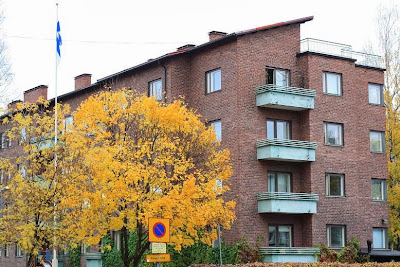 Site No. 49: Church of the Cross in Lahti (1969-79)
Site No. 49: Church of the Cross in Lahti (1969-79)
Today I have the pleasure to present another master piece of Aalto's work the so called Ristinkirkko or Church of the Chross in English. This stunning building is located in the center of Lahti on a hill and can easily be seen from the market square which is basically the centre of Lahti. It fits quite well into its environment without standing out too much.
This was the fourth and last church Aalto built in Finnland after the churches in Muuramme, Imatra and Seinäjoki which were presented in earlier posts. Certain similar elements especially of the Seinäjoki church but also of the one in Imatra can be found in Lahti. Among those are of course the large windows and the lamps. While the outside is kept in red brick, actually uncommon for Aalto's later works, the interiour is white and the furniture consists of natural light wood. The large wooden cross behind the altar is typical and stays as an example for all Aalto's churches.
A speciality is also the large cross in form of many small windows at the front wall above the main entrance:
The church seen when approaching from the street that comes up from the market square:

The main entrance doors:
A walk around the church, the building is surrounded by a park and a graveyard is located to its right:

When entering the church through the main entrance the large window cross becomes even more visible due to the incoming light. Fascinating are also the stairs leading to the second level:

The main room of the church is dominated by large windows that allow a lot of natural light to enter the building, a typical Aalto element:

A nice element are also the lamps which reminded me a lot about the lamps Aalto used for the Seinäjoki church:
Visiting the second floor give a totally different perspective and is highly recommended:



The window cross seen from the second floor:
Some more impressions from the first floor. It was actually difficult for me to leave this building, there were so many interesting details to discover ...

Fascinating was also the closeness to nature which was transfered into the building through large windows facing the surrounding park:
The Church of the Cross is for me truely one of Aalto's most stunning works. Since I have discovered this church I am visiting it almost every time when I go to Lahti which is due to the fact that I have relatives living there quite often case. Every time I visit this building I discover some new interesting detail that fascinates me. I would say this is a must see for all Aalto fans!
 Once again it is time to celebrate, this blog has been now online for 3 years! While I am writting these lines more than 15 000 people have visited this blog. When I started this blog three years ago I would not have expected that it might create so much of interest. I am honestly overwhelmed!
Once again it is time to celebrate, this blog has been now online for 3 years! While I am writting these lines more than 15 000 people have visited this blog. When I started this blog three years ago I would not have expected that it might create so much of interest. I am honestly overwhelmed!




























































































